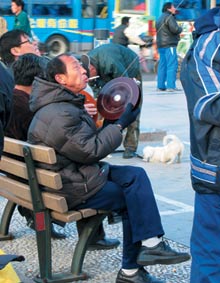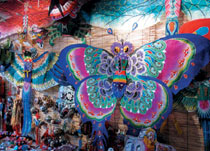
Each kite is hand made by Liu in his shop, using the simplest of materials: bamboo, fabric or paper, glue, twine, a candle and a knife. Using a quick sketch as a blueprint, Liu carefully uses a knife to cut the flexible but strong bamboo skin off the stalk. After stripping it clean, he places a lit candle beneath the strip to heat the bamboo and bend it into shape. When all the pieces of the frame are formed, he uses twine to bind together the bamboo strips into the desired shape. He then takes the completed frame and attaches, with glue, the fabric or paper. The final step is the painting of the kite: Here, Liu will put a great deal of thought into the images he paints, teasing out cultural references from simple objects. The entire process, on average, takes about one week.
A few minutes' walk from Liu Bin's shop in northwest Beijing is the home of another family of kite makers. The patriarch, Kong Lao, has been making kites for over 60 years. During the 1940s, Kong, then an art student, stumbled across a mysterious manuscript by the renowned Qing Dynasty author Cao Xueqin. Cao, author of the classic Chinese novel "Dream of the Red Chamber," was also an authority on traditional Chinese kites. His designs, which combined kite features found in southern China with those found in the North, influenced the development of kites in the Qing Dynasty. The manuscript, which described 40 methods for constructing kites, was the find of a lifetime and put Kong on a path which determined not only his life's work, but that of his sons and his grandsons. Today, his family continues to make kites by hand, based on the techniques and designs laid out by Cao Xueqin over 300 years ago.

Unlike Liu Bin, the Kongs do not sell their kites. Instead, the kites they create are donated to museums in China and around the world. But their work does not stop there: Kong's efforts in promoting kite culture carry on the entire legacy of Cao Xueqin, including the philosophy behind his work. "Cao Xueqin's goal in writing this text on kite making was to help the disabled by teaching them practical skills, thereby allowing them to make a living making kites," Kong's son, Kong Lingmin says. Guided by Cao's example, the Kongs themselves opened a training center for the disabled, where Kong Lingmin taught the mute, blind, and deaf how to make kites by hand. Though the endeavor eventually failed, the Kongs continue to promote the culture of traditional Chinese kites through classes at museums and exhibitions aimed mainly at unemployed workers and retirees.
Types of Kites
There are three major types of traditional kites commonly seen in the skies above China. The first type is the hard-wing kite, called so because the wings of the kite are reinforced on both the front and the back, forming a stiff wing capable of flying at high altitudes. These kites often take the shapes of swallows, eagles or other birds.
The second type, the soft-wing, is nearly identical in design, save for the fact that the back end of the wing is not reinforced and flutters freely in the wind. Typical shapes include butterflies, dragonflies and fish. All similarities end once the kites are in the air, however. According to kite maker Liu Bin, soft-wing kites are "like women, soft, natural, unrestrained, but not too strong. While they can't fly too high, they are beautiful, fluttering gracefully in the wind. The hard-wing kites are firm and unyielding, like men, and able to fly much higher."
The third type of kite is the dragon or centipede kite, which has a long body composed of dozens of segments connected by strands of twine. Unlike the two other kites, getting the dragon kite in the air requires special skill. This is because the most decorated part of the kite, the dragon head, doesn't aid in its flight-it's purely ornamental. Therefore, the kite is flown segment-by-segment, tail first, and only after the entire body is in flight is the dragon head attached.
![]() 北京市通信公司提供网络带宽
北京市通信公司提供网络带宽

